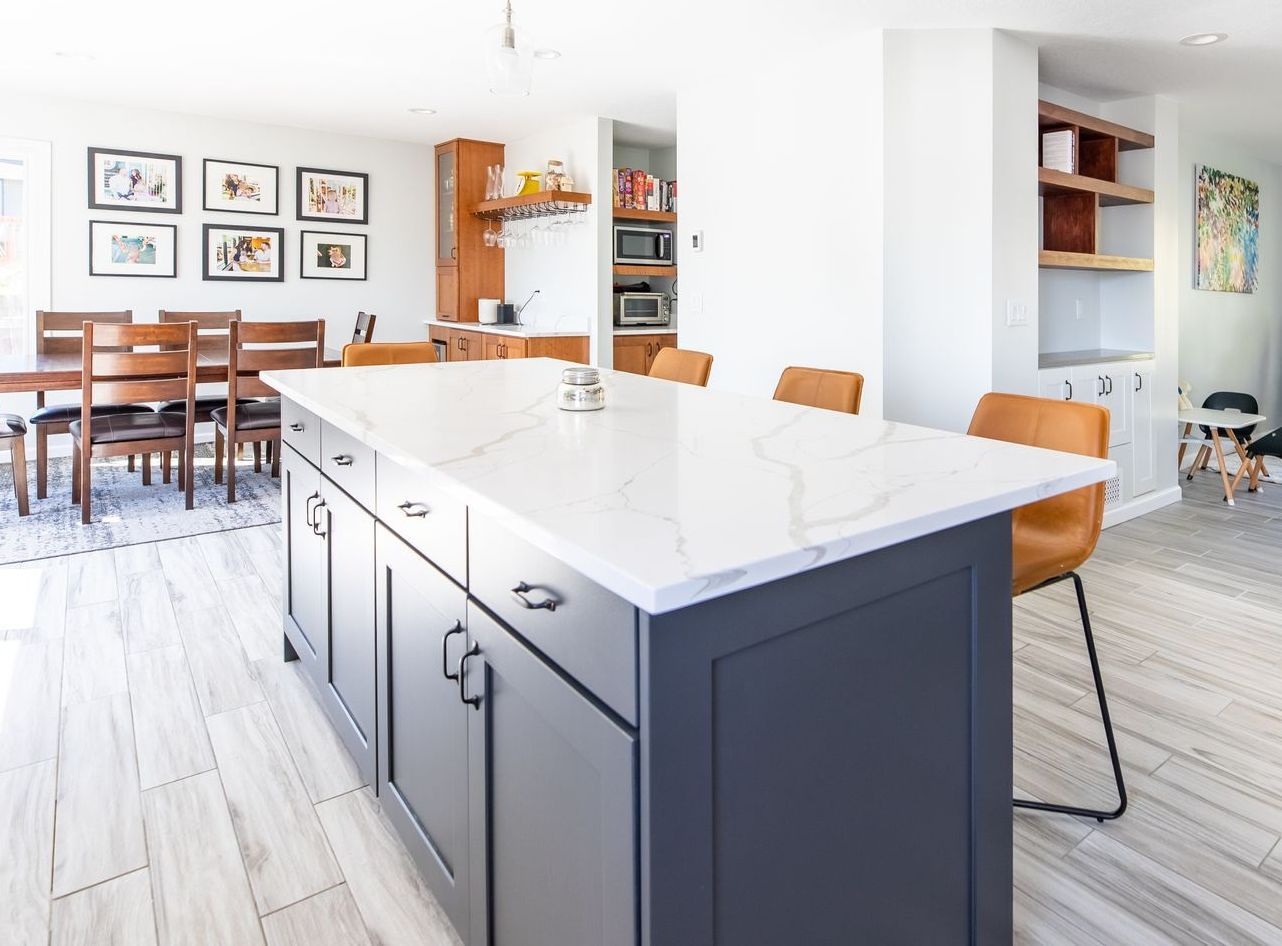Should Your Kitchen Island Be the Same Color as Your Cabinets? Expert Advice on Modern Design Trends
The kitchen island—it’s often the heartbeat of the kitchen. From preparing family meals to hosting friends, it’s a space where function meets style. So, it’s no surprise that homeowners often ask us, “Should the kitchen island be the same color as the cabinets?” At Loveless Construction, we understand that the design of your kitchen island plays a crucial role in how the entire space looks and feels. Whether you’re designing a timeless, traditional kitchen or opting for something more modern, choosing the right color scheme for your island can make or break the flow of your kitchen.
But with so many design trends swirling around, it's not always clear whether you should stick with a uniform color palette or take a bold leap with contrasting shades. Homeowners wrestle with the debate over matching or contrasting kitchen islands and cabinets daily. Loveless Construction is here to break it down for you, exploring current trends, expert advice, and practical tips on how to create a kitchen island that complements your cabinets—or stands out on its own. Let’s examine whether matching your kitchen island with your cabinets is still on trend or if now is the time to explore a more dynamic design.
The Timeless Look: Matching Kitchen Island and Cabinets
For a long time, matching your kitchen island to your cabinets was the go-to design choice. The concept was straightforward: if your cabinets were a particular color, it made sense to keep the island in the same tone. This approach fosters a sense of harmony, creating a smooth, uninterrupted flow in the kitchen. Even in more traditional kitchen designs, this method remains popular, as it helps maintain symmetry and balance throughout the space.
When you match your kitchen island to your cabinets, you’re choosing a path of simplicity, elegance, and quiet sophistication. Think about a serene white farmhouse kitchen or a warm oak setup where both the island and cabinetry share the same hue. The key here is cohesion—everything looks like it belongs, contributing to a timeless, classical vibe. Plus, a uniform color scheme can work wonders in smaller kitchens, making the space appear more open and spacious.
If you’re aiming for a traditional, rustic, or coastal-inspired kitchen, matching your island to your cabinets can be a great choice. These styles often feature soft colors and natural textures, with the island blending seamlessly into the cabinetry. This approach creates a calm, cohesive atmosphere, allowing the space to flow naturally without any one element overpowering the rest of the kitchen.
However, while this approach is still a solid choice, it’s not the only option anymore. Let’s talk about why many homeowners are stepping away from this look and opting for something bolder.
A Modern Twist: Contrasting Kitchen Islands
Recently, contrasting kitchen islands have become a popular choice in kitchen design. What was once considered a bold risk is now an opportunity to showcase your personal style and craft a kitchen that truly reflects your individuality. Contrasting islands are not only stylish, but they also add depth, dimension, and interest to the kitchen. This trend works particularly well if your cabinets are neutral tones, like white, gray, or navy. By introducing a darker, richer island color—such as charcoal, deep forest green, or even a wood finish—you can create a beautiful focal point in the room. If you’re feeling bolder, a vibrant pop of color like teal or mustard yellow on the island can breathe life into the space, transforming a dull kitchen into an exciting one.
The Magic of Materials
When contrasting your island with your cabinets, color is not the only consideration. Material contrast has become just as important. For instance, you might have sleek white cabinetry, but a kitchen island made of reclaimed wood or with a marble countertop can completely change the look of your kitchen. The contrast in materials brings texture into the mix, elevating the design and giving the space an almost three-dimensional feel.
Benefits of Contrasting Kitchen Islands:
- Personalized Design: When you choose a contrasting island, you’re essentially stamping the space. It’s your chance to bring something personal into your kitchen—something that reflects your taste, whether that’s bold and contemporary or playful and fun.
- Creates a Focal Point: A contrasting island naturally draws attention. Whether it’s a bright color or a bold material, it quickly becomes the heart of the kitchen. This adds visual interest and can help balance out the rest of the room.
- Versatility Across Styles: Contrasting islands work well in contemporary and transitional kitchens. They allow you to easily experiment with different finishes and colors, making them suitable for homeowners who like to update their décor periodically.
- Defining Work Zones: In larger kitchens, contrasting islands help to visually divide the space into functional areas. For example, the island can serve as a prep area, while the cabinets provide storage, creating a subtle distinction between the work zones.

When Should You Keep the Island and Cabinets the Same Color?
Of course, contrasting kitchen islands are not the best fit for every space. Here are a few scenarios where keeping the island and cabinets the same color makes sense:
- Small Kitchens: If your kitchen is limited in size, a matching island and cabinet combination can make the space feel larger and more open. The uniformity creates a seamless flow, and the absence of bold contrast helps avoid overwhelming the space.
- Classic or Traditional Designs: For homeowners who love timeless appeal, a matching island and cabinetry are a classic choice. Whether you’re working with vintage oak or sleek white cabinetry, the matchy-matchy look fits seamlessly into kitchens with traditional, Mediterranean, or even some transitional styles.
- Less is More: If you’re a fan of minimalism or if your kitchen already features bold elements—like intricate backsplashes or statement countertops—a matching island can serve as a quiet companion to the bolder elements in the room. It allows other features to take center stage while maintaining a sense of balance.
- Showcasing High-End Materials: If you’ve invested in high-quality materials for your cabinets and island—like beautiful solid wood or fine lacquer finishes—matching them can allow those materials to shine without distraction. This is especially true when you’ve selected materials that deserve to be the star of the show.
Making the Final Decision: Matching vs. Contrasting
At the end of the day, whether you choose to match or contrast your kitchen island with your cabinets comes down to your personal taste, lifestyle, and the look you want to achieve. Both approaches have their benefits, and neither is inherently better than the other—it’s all about what feels right for your space. If you’re looking for a cohesive, unified look that will withstand trends, matching your island and cabinets might be your best bet. On the other hand, if you want to embrace something more contemporary and dynamic, a contrasting island could be the perfect way to breathe new life into your kitchen.
When in doubt, consider these questions:
- How does the rest of your kitchen feel? Are you looking to emphasize a specific feature, or do you want everything to blend together?
- Do you prefer a more classic, understated look, or are you ready to experiment with color and contrast?
- What kind of atmosphere are you trying to create? A calm, serene space or one with energy and excitement?
Making the Right Choice: Matching or Contrasting Your Kitchen Island and Cabinets
The question of whether your kitchen island should match your cabinets doesn’t have a one-size-fits-all answer. It’s all about understanding your personal preferences and how they align with current design trends. Whether you choose to blend the island with the cabinetry or opt for a bold contrast, the key is to make sure your choice complements the overall style of your kitchen and enhances its functionality.
If you're not sure how to incorporate a matching or contrasting kitchen island into your design, our team at Loveless Construction is here to help. We specialize in crafting kitchens that blend your style with your practical needs. Contact us today to learn how we can help you create the perfect kitchen that balances color, style, and functionality.
Useful Links
Working Hours
- Mon - Fri
- -
- Saturday
- -
- Sunday
- Closed
All Rights Reserved | Loveless Construction. | Sitemap
